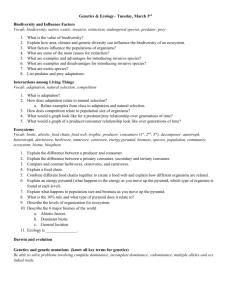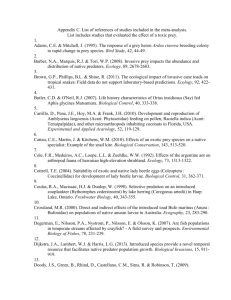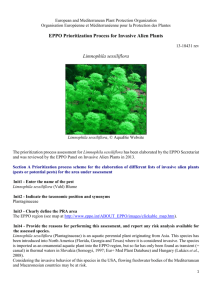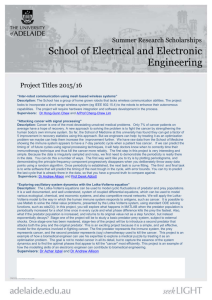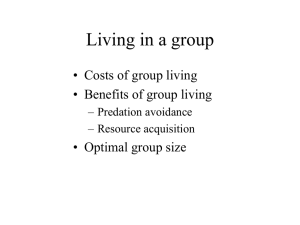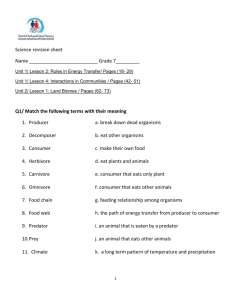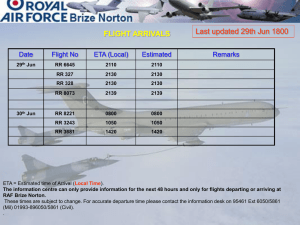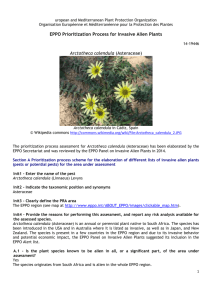gcb12603-sup-0001-TableS1
advertisement
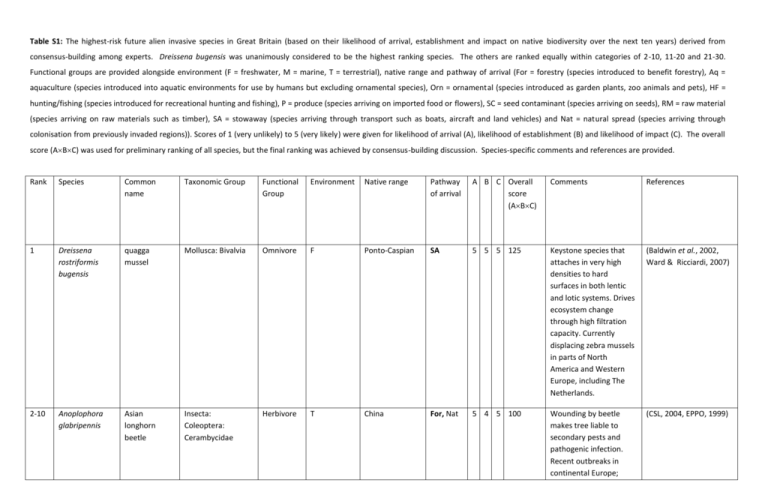
Table S1: The highest-risk future alien invasive species in Great Britain (based on their likelihood of arrival, establishment and impact on native biodiversity over the next ten years) derived from consensus-building among experts. Dreissena bugensis was unanimously considered to be the highest ranking species. The others are ranked equally within categories of 2-10, 11-20 and 21-30. Functional groups are provided alongside environment (F = freshwater, M = marine, T = terrestrial), native range and pathway of arrival (For = forestry (species introduced to benefit forestry), Aq = aquaculture (species introduced into aquatic environments for use by humans but excluding ornamental species), Orn = ornamental (species introduced as garden plants, zoo animals and pets), HF = hunting/fishing (species introduced for recreational hunting and fishing), P = produce (species arriving on imported food or flowers), SC = seed contaminant (species arriving on seeds), RM = raw material (species arriving on raw materials such as timber), SA = stowaway (species arriving through transport such as boats, aircraft and land vehicles) and Nat = natural spread (species arriving through colonisation from previously invaded regions)). Scores of 1 (very unlikely) to 5 (very likely) were given for likelihood of arrival (A), likelihood of establishment (B) and likelihood of impact (C). The overall score (ABC) was used for preliminary ranking of all species, but the final ranking was achieved by consensus-building discussion. Species-specific comments and references are provided. Rank Species Common name Taxonomic Group Functional Group Environment Native range Pathway of arrival A B C Overall score (ABC) Comments References 1 Dreissena rostriformis bugensis quagga mussel Mollusca: Bivalvia Omnivore F Ponto-Caspian SA 5 5 5 125 Keystone species that attaches in very high densities to hard surfaces in both lentic and lotic systems. Drives ecosystem change through high filtration capacity. Currently displacing zebra mussels in parts of North America and Western Europe, including The Netherlands. (Baldwin et al., 2002, Ward & Ricciardi, 2007) 2-10 Anoplophora glabripennis Asian longhorn beetle Insecta: Coleoptera: Cerambycidae Herbivore T China For, Nat 5 4 5 100 Wounding by beetle makes tree liable to secondary pests and pathogenic infection. Recent outbreaks in continental Europe; (CSL, 2004, EPPO, 1999) some recent interceptions in GB, including an outbreak in 2012 in Kent which was controlled. 2-10 Hemigrapsus sanguineus Asian shore crab Crustacea: Brachyura Predator M Asia (Pacific) SA 5 5 4 100 Likely to out-compete and displace native crab species especially the shore crab, Carcinus maenas. (Dauvin, 2009, Dauvin et al., 2009, Jensen et al., 2002) 2-10 Hemigrapsus takanoi brush-clawed shore crab Crustacea: Brachyura Predator M Asia (Pacific) SA 5 5 4 100 Likely to out compete and displace native crab species especially the shore crab, Carcinus maenas. (Dauvin, 2009, Dauvin & Delhay, 2010) 2-10 Homarus americanus American lobster Crustacea : Astacidea Predator M North America Aq 5 4 5 100 American lobsters carry a bacterial disease, Gaffkaemia, that is lethal to other Homarus spp., and an epizootic shell disease may be transferred with American lobsters to Europe. This disease has resulted in the closing of parts of the North American lobster fishery and its impact on European lobster populations/fisheries could be equally severe. Hybridisation with the (Jørstad et al., 2011, Stebbing et al., 2012) native H. gammarus is also an issue. Continues to be released into GB waters in small numbers following purchase from restaurants, where they are being displayed before cooking, and released into local waters. 2-10 Myriophyllum heterophyllum American water-milfoil Angiosperm: Haloragaceae Primary producer F North America Orn 5 5 4 100 Widely grown in aquaria/ponds and with capacity to become established and highly invasive. (EPPO, 2013, Preston & Croft, 1997, Thum & Lennon, 2010) 2-10 Neogobius melanostomus round goby Perciformes: Gobiidae Predator F Ponto-Caspian SA 4 5 5 100 The numbers of native fish species have declined in areas where the round goby has become abundant. Fish eggs, insect larvae and snails are also eaten. They also show a strong preference for zebra and quagga mussels. (Vanderploeg et al., 2002) 2-10 Procyon lotor raccoon Mammalia: Carnivora Predator T North and Central America Orn 5 4 5 100 Regular escape/release from captivity in GB (invariably as single individuals), well established populations in central and western Europe. Potentially major vector of disease, e.g. rabies. (Baker & Hills, 2008, Parrott et al., 2008) 2-10 Threskiornis aethiopicus African sacred ibis Aves: Pelecaniformes Predator T Sub-Saharan Africa Nat 5 4 5 100 Potentially serious predator of birds and amphibians – including species of conservation concern. Well established and spreading in France; individuals seen in GB. (Blair et al., 2000, Parrott et al., 2008, Yesou & Clergeau, 2006) 2-10 Vespa velutina Asian hornet Insecta: Hymenoptera: Vespidae Predator T China SA, P, Nat 5 5 4 100 Important predator, especially of honeybees, other bees & social wasps, and also Diptera. Recent arrival (2004) in S.W. France and spreading rapidly north and east; GB has suitable climate & habitat. (EPPO, 2007, Marris & Roy, 2013, Villemant et al., 2011) 1120 Thaumetopoea pityocampa Pine processionary moth Insecta: Lepidoptera: Thaumetopoeidae Herbivore T Mediterranean region, North Africa, Middle East For, Nat 5 4 5 100 Economically important pest; urticating hairs pose health hazard; most Pinus species susceptible but also certain broadleaved tree species. Abundant in southern & central Europe, expanding northwards in France; transient larval population in GB on imported saplings intercepted in 1995. (Baker et al., 2012, Battisti et al., 2005, EPPO, 2004) 1120 Baccharis halimifolia sea myrtle, saltbush Angiosperm: Asteraceae Primary producer T North America Orn 5 5 4 100 Forms dense monospecific stands in coastal sites (Caño et al., 2013, EPPO, 2009, EPPO, 2013, Etienne et al., 2010) 1120 Corbicula fluminalis Asian clam Mollusca: Bivalvia: Corbiculidae Omnivore F Eastern Asia SA 4 5 5 100 An ecosystem engineer, driving ecological change to river systems through its high densities coupled with large filtration capacity. Widely present across Western Europe, including France and The Netherlands. (Bodis et al., 2011) 1120 Corvus splendens Indian house crow Aves: Passeriformes Omnivore T Southern Asia SA 4 4 5 80 Adaptable and widespread invasive species globally with evidence of negative impact on native birds. Already in close proximity in Netherlands and very likely to arrive in GB by ship. (Nyari et al., 2006, Ottens, 2003, Ottens & Ryall, 2003) 1120 Echinogammaru s trichiatus curly haired urchin shrimp Crustacea: Gammaridea Omnivore F Ponto-Caspian SA 5 5 3 75 Wide diet and high densities suggests a capacity to drive pronounced change to invaded systems. Can be found in lotic and lentic systems, and often associated with rocks, sand and reeds. In The Netherlands the species is often sampled together with zebra mussels. (Bij de Vaate et al., 2002) 11- Linepithema Argentine ant Insecta: Predator T South America SA, P, Nat 5 3 5 75 Strong adverse impacts (Roura-Pascual et al., Hymenoptera: Formicidae 20 humile 1120 Mnemiopsis leidyi American comb jelly Ctenophora: Lobata Predator M North America and South America SA 1120 Nassella neesiana (Stipa neesiana) Chilean needle grass Angiosperm: Poaceae Primary producer T South America Orn on native ant species, other arthropods and ecosystem services / plant interactions (pollination & seed dispersal). Introduced worldwide, including Mediterranean region and Iberia; spread facilitated by climatic warming but may be limited in Britain by winter temperature. 2010, Roura-Pascual et al., 2011, Roura-Pascual et al., 2004, Wetterer et al., 2009) 5 5 4 100 Voracious predator of zooplankton including fish larvae and eggs. This species has been responsible for serious impacts in the Black Sea. Threat to more enclosed waters, especially of lower salinity. (Faasse & Bayha, 2006, Finenko et al., 2006) 5 5 3 75 Increasingly cultivated because of current popularity of ornamental grasses; EPPO moved it from Alert to Observation list in 2012 with the similar N. tenuissima (prefers drier climates) and N. trichotoma (warmer summers). (Bourdôt et al., 2012, EPPO, 2013) 1120 Proterorhinus marmoratus tubenose goby Actinopterygii: Perciformes Predator F Ponto-Caspian SA 4 5 5 100 Evidence of diet overlap with native fishes, but unlike round goby does not feed on zebra mussels. Established widely in The Netherlands. (French & Jude, 2001) 1120 Rapana venosa veined rapa whelk Mollusca: Gastropoda Predator M Asia (Pacific) SA, Aq 5 4 5 100 Large predatory gastropod, consumes a range of ecologically and commercially important invertebrates. Currently in North Sea, France and Netherlands. Very serious impacts in the Black Sea. Only limitation is current climate regime in GB waters, which may limit larval survival. (ICES, 2004, Mann & Harding, 2000) 2130 Agrilus plannipennis Emerald ash borer Insecta: Coleoptera: Buprestidae Herbivore T Asia For, Nat 3 5 4 60 One of most destructive forest pests in USA & Canada, attacking Fraxinus spp.; not yet arrived in Europe;. Kills trees in 2-5 yrs; can affect entire stands with consequent impact on forest composition, succession and biogeochemical cycling. (Flower et al., 2013a, Flower et al., 2013b, Sobek-Swant et al., 2012) 2130 Celtodoryx ciocalyptoides a sponge Porifera: Poecilosclerida Omnivore M Pacific SA, Aq 5 4 3 60 Suspension feeder growing into very extensive patches. Variety of growth forms (Henkel & Janussen, 2011, Perez et al., 2006, van Soest et al., 2007) depending on habitat. Grows on Eunicella verrucosa (a slow growing, fragile, habitat forming species) but effects not studied. Extensive epifauna/flora. 2130 Dryocosmus kuriphilus oriental chestnut gall wasp Insecta: Hymenoptera: Cynipidae Herbivore T China For, Nat 3 5 3 45 Causes up to 70% loss of fruit yield and may cause death of trees; possible positive interaction with chestnut blight. First recorded in Italy in 2002, France in 2005; spreading at approx 8km year; Britain is climatically suitable. (Bernardo et al., 2013, Prospero & Forster, 2011) 2130 Echinogammaru s ischnus bald urchin shrimp Crustacea: Gammaridea Omnivore F Ponto-Caspian SA 5 5 3 75 In the Great Lakes in North America it forms relatively high densities in zebra musseldominated habitats, despite its somewhat lower fecundity and shorter life span in comparison to the indigenous gammarid species. Other established invasive gammarids in GB (e.g. Gammarus tigrinus, Dikerogammarus villosus) may suppress the impacts of this omnivore in some systems. Established and (Bij de Vaate et al., 2002) widespread in The Netherlands. 2130 Gyrodactylus salaris salmon fluke Platyhelminthes: Trematoda Parasite F Baltic HF, Aq, SA 5 4 4 80 A very small trematode parasite (<1mm) which attaches to the outer body and gills of salmon. It damages the skin and this can lead to infections. It has led to significant mortality of young salmon in river catchments in Norway, northern Finland and the White Sea area. Most vulnerable region in GB is Scotland, although strict species-specific biosecurity measures reduce the likelihood of introduction. (Johnsen & Jensen, 1991) 2130 Microstegium vimineum Japanese stiltgrass Angiosperm: Poaceae Primary producer T Central and eastern Asia SC, RM 3 4 5 60 Potentially a highly invasive species in GB but currently with a very restricted distribution in Europe. (Adams & Engelhardt, 2009, EPPO, 2013, Gibson et al., 2002) 2130 Nyctereutes procyonoides raccoon dog Mammalia: Carnivora Predator T Eastern Asia (Vietnam to Russia) Orn 4 3 5 60 Rare escape/release in GB (invariably as single individuals) but abundant and increasing in central and eastern Europe. Fecund, adaptable, and potential threat to game birds, wildfowl and as vector of (Kauhala & Kowalczyk, 2011, Parrott et al., 2008) disease. 2130 Ocenebra inornata Japanese sting winkle Mollusca: Gastropoda Predator M Asia (Pacific) SA, Aq 5 4 4 80 A predator of bivalves. Possibly already here. Identification confusion possible with European stingwinkle. (Considered a serious threat to oysters in France.) (Lützen et al., 2011) 2130 Tamias sibiricus Siberian chipmunk Mammalia: Rodentia Omnivore T Northern Asia (Kazahkstan to Japan) Orn 5 4 4 80 Predator of groundnesting birds and potential to compete with native rodents. Regular escape from captivity, often multiple individuals; proven establishment and spread in western Europe. (Long, 2003, Parrott et al., 2008) 2130 Gracilaria vermiculophylla rough agar weed Rhodophyta: Gracilariaceae Producer M Pacific SA, Aq 5 5 4 100 May impact Fucus vesiculosus (a key intertidal algal species on GB shores) populations and other native algae by means of several complex interactions. Able to grow rapidly and colonise large areas and is highly tolerant of low salinities. Possible interactions with sea grass beds and saltmarsh habitat. Thought to be present on South Coast of England but not (Nejrup et al., 2012, Thomsen et al., 2009, Weinberger et al., 2008) established. Adams SN, Engelhardt KaM (2009) Diversity declines in Microstegium vimineum (Japanese stiltgrass) patches. Biological Conservation, 142, 1003-1010. Baker R, Anderson H, Matthews-Berry S, Korycinska A (2012) Rapid Pest Risk Analysis for Thaumetopoea pityocampa (the Pine Processionary Moth). York, FERA. Baker SJ, Hills D (2008) Escapes and introductions. In: The Mammals of the British Isles: Handbook, 4th Edition (eds Harris S, Yalden D) pp 780-794. Southampton, The Mammal Society. Baldwin BS, Mayer MS, Dayton J et al. (2002) Comparative growth and feeding in zebra and quagga mussels (Dreissena polymorpha and Dreissena bugensis): implications for North American lakes. Canadian Journal of Fisheries and Aquatic Sciences, 59, 680-694. Battisti A, Stastny M, Netherer S, Robinet C, Schopf A, Roques A, Larsson S (2005) Expansion of geographic range in the pine processionary moth caused by increased winter temperatures. Ecological Applications, 15, 2084-2096. Bernardo U, Gebiola M, Ixiao Z, Zhu C-D, Pujade-Villar J, Viggiani G (2013) Description of Synergus castaneus n. sp. (Hymenoptera: Cynipidae:Synergini) Associated With an Unknown Gall on Castanea spp. (Fagaceae) in China. Annals of the Entomological Society of America, 106, 437-446. Bij De Vaate A, Jazdzewski K, Ketelaars HaM, Gollasch S, Van Der Velde G (2002) Geographical patterns in range extension of Ponto-Caspian macroinvertebrate species in Europe. Canadian Journal of Fisheries and Aquatic Sciences, 59, 1159-1174. Blair MJ, Mckay H, Musgrove AJ, Rehfisch MM (2000) Review of the status of introduced non-native waterbird species in the Agreement area of the African-Eurasian Waterbird Agreement. (ed Ornithology BTF), Thetford. Bodis E, Nosek J, Oertel N, Toth B, Feher Z (2011) A comparative study of two Corbicula morphs (Bivalvia, Corbiculidae) inhabiting River Danube. International Review of Hydrobiology, 96, 257-273. Bourdôt GW, Lamoureaux SL, Watt MS, Manning LK, Kriticos DJ (2012) The potential global distribution of the invasive weed Nassella neesiana under current and future climates. Biological Invasions, 14, 1545-1556. Caño L, Campos JA, Garcia-Magro D, Herrera M (2013) Replacement of estuarine communities by an exotic shrub: distribution and invasion history of Baccharis halimifolia in Europe. Biological Invasions, 15, 1183-1188. Csl (2004) Asian Longhorn Beetles. Dauvin J-C (2009) Establishment of the invasive Asian shore crab Hemigrapsus sanguineus (De Haan, 1835) (Crustacea: Brachyura: Grapsoidea) from the Cotentin Peninsular, Normandy, France. Aquatic Invasions, 4, 467-472. Dauvin J-C, Delhay J-B (2010) First record of Hemigrapsus takanoi (Crustacea: Decapoda: Grapsidae) on the western coast of northern Cotentin, Normandy, western English Channel. Marine Biodiversity Records, 3, 1-3. Dauvin J-C, Tous Rius A, Ruellet T (2009) Recent expansion of two invasive crab species Hemigrapsus sanguineus (de Haan, 1835) and H. takanoi Asakura and Watanabe 2005 along the Opal Coast, France. Aquatic Invasions, 4, 451-465. Eppo (1999) EPPO Datasheets on Quarantine Pests Anoplophora glabripennis. Eppo (2004) Diagnostic protocols for regulated pests. Bulletin OEPP/EPPO 34, 34, 155 –157. Eppo (2007) Vespa velutina: a new invasive alien species found in France. Eppo (2009) Mini data sheet: Baccharis halimifolia (Asteraceae). Eppo (2013) EPPO List of Invasive Plants. Etienne B, Vanderhoeven S, Van Landuyt W, Van Rossum F, Verloove F (2010) Baccharis halimifolia - Eastern baccharis. (ed Species BFOI), Brussels. Faasse MA, Bayha KM (2006) The ctenophore Mnemiopsis leidyi A.Agassiz 1865 in coastal waters of the Netherlands: an unrecognized invasion? . Aquatic Invasions, 1, 270-277. Finenko GA, Kideys AE, Anninsky BE et al. (2006) Invasive ctenophore Mnemiopsis leidyi in the Caspian Sea: feeding, respiration, reproduction and predatory impact on the zooplankton community. Marine Ecology Progress Series, 314, 171-185. Flower CE, Knight KS, Gonzalez-Meler MA (2013a) Impacts of the emerald ash borer (Agrilus planipennis Fairmaire) induced ash (Fraxinus spp.) mortality on forest carbon cycling and successional dynamics in the eastern United States. Biological Invasions, 15, 931-944. Flower CE, Knight KS, Rebbeck J, Gonzalez-Meler MA (2013b) The relationship between the emerald ash borer (Agrilus planipennis) and ash (Fraxinus spp.) tree decline: Using visual canopy condition assessments and leaf isotope measurements to assess pest damage. Forest Ecology and Management, 303, 143-147. French JRP, Jude DJ (2001) Diets and diet overlap of nonindigenous gobies and small benthic native fishes co-inhabitating the St. Clair River, Michigan. Journal of Great Lakes Research, 27, 300-311. Gibson DJ, Spyreas G, Benedict J (2002) Life history of Microstegium vimineum (Poaceae), an invasive grass in southern Illinois. Journal of the Torrey Botanical Society, 129, 207-219. Henkel D, Janussen D (2011) Redescription and new records of Celtodoryx ciocalyptoides (Demospongiae: Poecilosclerida)-a sponge invader in the north east Atlantic Ocean of Asian origin? Journal of the Marine Biological Association of the United Kingdom, 91, 347-355. Ices (2004) Alien Species Alert: Rapana Venosa (veined whelk). In: ICES Cooperative Research Report. (eds Mann R, Occhipinti A, Harding JM) pp 14. Jensen GC, Mcdonald PS, Armstrong DA (2002) East meets west: competitive interactions between green crab Carcinus maenus, and native and introduced shore crab Hemigrapsus spp. Marine Ecology Progress Series, 225, 251-262. Johnsen BO, Jensen AJ (1991) The Gyrodactylus story in Norway. Aquaculture, 98, 289-302. Jørstad KE, A-L. A, Farestveit E (2011) The Introduced American Lobster, Homarus americanus in Scandinavian Waters. In: In the Wrong Place - Alien Marine Crustaceans: Distribution, Biology and Impacts, Invading Nature. (eds Galil BS, Clark PF, Carlton JD) pp 625-638. Springer. Kauhala K, Kowalczyk R (2011) Invasion of the raccoon dog Nyctereutes procyonoides in Europe: history of colonisation, features behind its success and threats to native fauna. Current Zoology, 57, 584-598. Long JL (2003) Introduced Mammals of the World: their history, distribution and influence, Oxford, CABI Publishing. Lützen J, Faasse M, Gittenberger A, Glennen H, Hoffmann E (2011) The Japanese oyster drill Ocinebrellus inornatus (Récluz, 1851) (Mollusca, Gastropoda, Muricidae), introduced to the Limfjord, Denmark. Aquatic Invasions, 7, 181–191. Mann R, Harding JM (2000) Invasion of the North American Atlantic coast by a large predatory Asian mollusc. Biological Invasions, 2, 7-22. Marris G, Roy HE (2013) Asian hornet: mistaken identity. Bee Craft, 95, 30-32. Nejrup LB, Pedersen MF, J. V (2012) Grazer avoidance may explain the invasiveness of the red alga Gracilaria vermiculophylla in Scandinavian waters. Marine Bioloy, 159, 1703–1712. Nyari A, Ryall C, Peterson AT (2006) Global invasive potential of the house crow Corvus splendens based on ecological niche modelling. Journal of Avian Biology, 37, 306-311. Ottens G (2003) Background and development of the Dutch population of House Crows Corvus splendens. Limosa, 76, 69-74. Ottens G, Ryall C (2003) House Crows in the Netherlands and Europe. Dutch Birding, 25, 312-319. Parrott D, Roy S, Fletcher M (2008) The status of scarce non-native birds and mammals in England. Central Science Laboratory. Perez T, Perrin B, Carteron S, Vacelet J, Boury-Esnault N (2006) Celtodoryx girardae gen. nov sp nov., a new sponge species (Poecilosclerida : Demospongiae) invading the Gulf of Morbihan (North East Atlantic, France). Cahiers De Biologie Marine, 47, 205-214. Preston CD, Croft JM (1997) Aquatic plants in Britain and Ireland, Colchester, Harley Books. Prospero S, Forster B (2011) Chestnut gall wasp (Dryocosmus kuriphilus) infestations: new opportunities for the chestnut blight fungus Cryphonectria parasitica? New Disease Reports, 23, 35. Roura-Pascual N, Bas JM, Hui C (2010) The spread of the Argentine ant: environmental determinants and impacts on native ant communities. Biological Invasions, 12, 2399-2412. Roura-Pascual N, Hui C, Ikeda T et al. (2011) Relative roles of climatic suitability and anthropogenic influence in determining the pattern of spread in a global invader. Proceedings of the National Academy of Sciences of the United States of America, 108, 220-225. Roura-Pascual N, Suarez AV, Gomez C, Pons P, Touyama Y, Wild AL, Peterson AT (2004) Geographical potential of Argentine ants (Linepithema humile Mayr) in the face of global climate change. Proceedings of the Royal Society B-Biological Sciences, 271, 2527-2534. Sobek-Swant S, Kluza DA, Cuddington K, Lyons DB (2012) Potential distribution of emerald ash borer: What can we learn from ecological niche models using Maxent and GARP? Forest Ecology and Management, 281, 23-31. Stebbing P, Johnson P, Delahunty A, Clark PF, Mccollin T, Hale C, Clark S (2012) Reports of American lobsters, Homarus americanus (H. Milne Edwards, 1837) (Crustacea: Decapoda: Astacidea: Nephropoidea) in Great British waters. BioInvasions Records, 1, 17-23. Thomsen MS, Mcglathery KJ, Schwarzschild A, Silliman BR (2009) Distribution and ecological role of the non-native macroalga Gracilaria vermiculophylla in Virginia salt marshes. Biological Invasions, 11, 2303–2316. Thum RA, Lennon JT (2010) Comparative ecological niche models predictive the invasive spread of variable-leaf milfoil (Myriophyllum heterophllum) and its potential impact on closely related native species. Biological Invasions, 12, 133-143. Van Soest RWM, De Kluijver MJ, Van Bragt PH et al. (2007) Sponge invaders in Dutch coastal waters. Journal of the Marine Biological Association of the United Kingdom, 87, 1733-1748. Vanderploeg HA, Nalepa TF, Jude DJ et al. (2002) Dispersal and emerging ecological impacts of Ponto-Caspian species in the Laurentian Great Lakes. Canadian Journal of Fisheries and Aquatic Sciences, 59, 1209-1228. Villemant C, Barbet-Massin M, Perrard A, Muller F, Gargominy O, Jiguet F, Rome Q (2011) Predicting the invasion risk by the alien bee-hawking Yellow-legged hornet Vespa velutina nigrithorax across Europe and other continents with niche models. Biological Conservation, 144, 2142-2150. Ward JM, Ricciardi A (2007) Impacts of Dreissena invasions on benthic macroinvertebrate communities: a meta-analysis. Diversity and Distributions, 13, 155-165. Weinberger F, Buchholz B, Karez R, Wahl M (2008) The invasive red alga Gracilaria vermiculophylla in the Baltic Sea: adaptation to brackish water may compensate for light limitation. Aquatic Biology, 3, 251–264. Wetterer JK, Wild AL, Suarez AV, Roura-Pascual N, Espadaler X (2009) Worldwide spread of the Argentine ant, Linepithema humile (Hymenoptera: Formicidae). Myrmecological News, 12, 187-194. Yesou P, Clergeau P (2006) Sacred Ibis: a new invasive species in Europe. Birding World, 18, 517-526.

